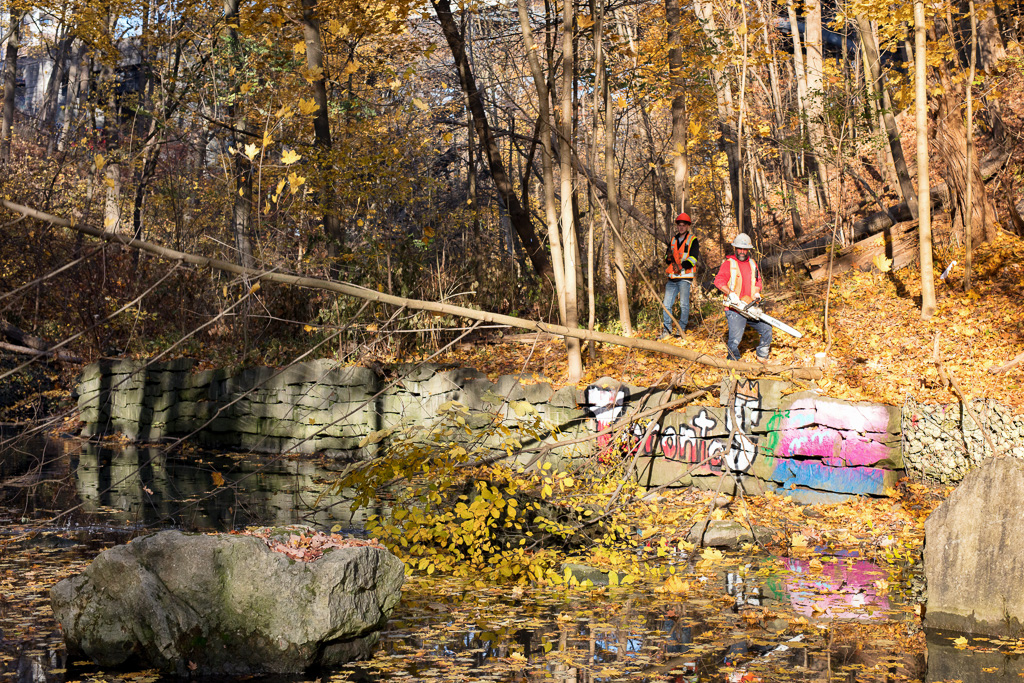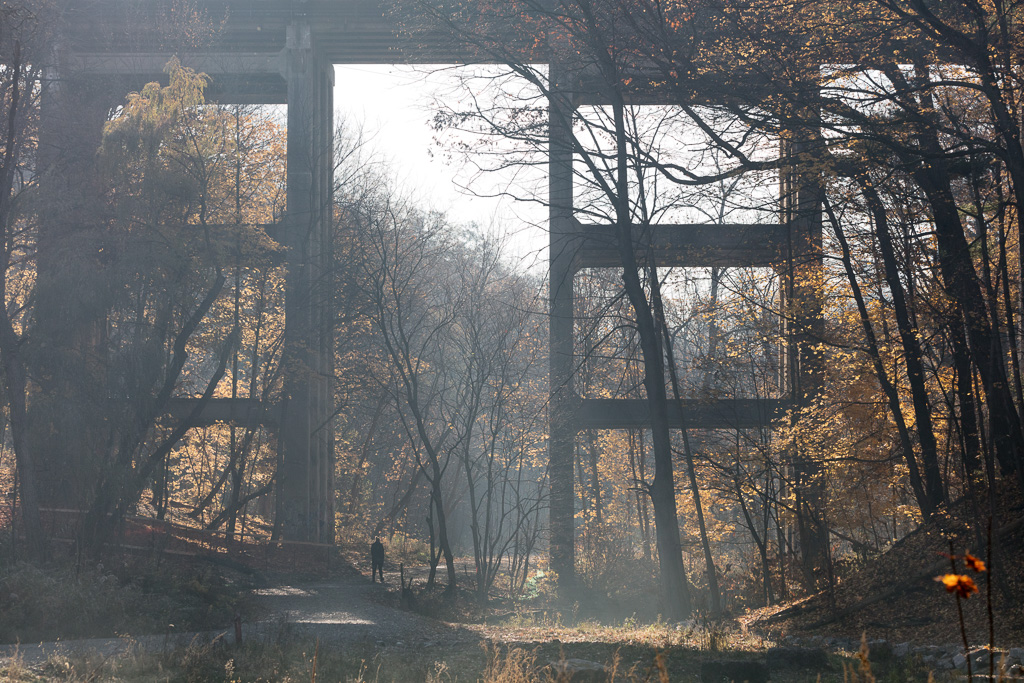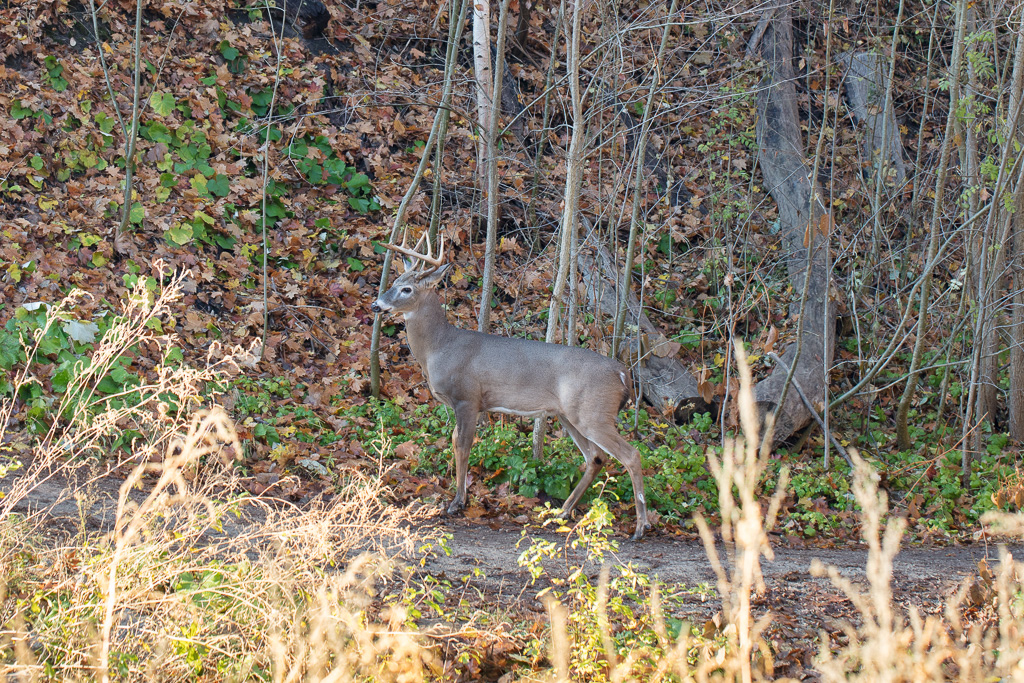Tired of being cooped up indoors, I went out early to catch the morning light in Yellow Creek, a ravine not far from my condo in downtown Toronto. Like most people who dabble in landscape photography, I like to play a fantasy game with myself. It’s called: let’s pretend the scene we’re capturing is an entirely natural scene. For city-bound people like me, this is an especially tempting game to play. Part of the trick is to frame a shot to eliminate anything unnatural from the scene, like buildings, overhead wires, and fence posts. Another part of the trick happens in post-production with the help of image editing software. After taking the photo above, I should have removed the hint of blue plastic caught in the underbrush on the left bank of the river. I should also have done something about the rocks in the foreground which have been scored by a machine. But I’m a lazy when it comes to fantasy games and often forget about these details. Besides, it strikes me as disingenuous to pretend I’m in a natural setting when, all around me, the scene screams of human interference. All I have to do is turn around and this is what I see:

Photographers aren’t the only people acutely concerned with the way human beings have transformed their environment. Epidemiologists have an interest too. As we all are discovering, when infectious disease experts talk about the aetiology of the SARS-CoV-2 virus, they don’t treat it as an alien thing that evolved in the wilderness and suddenly emerged from its native swamp to attack us. Instead, they acknowledge that it is an organism of our creating. We may not have engineered it, as some conspiracy theorists would have us believe, but we are nevertheless responsible for establishing the conditions which allowed it to thrive. Similarly, when infectious disease experts talk about preventive measures we can take to stave off future pandemics, they don’t talk about frequent hand-washing or even about the elimination of wet markets. Instead, they talk about dismantling great swaths of our structural organization as social and political beings. Like proponents of the Black Lives Matter movement, they advocate systemic change from top to bottom.

Moving further upstream, I came upon to workers cutting down trees. I took this shot while standing on some rocks in the middle of the river. Behind me, on the opposite bank, a backhoe was working its way down the slope from Avoca Avenue. Naively, I asked if they were arborists. No, they explained, they were clearing a path so they could get heavy equipment underneath the St. Clair Ave. E. bridge to repair the four-foot concrete pipes that have broken apart there. I know those pipes. I included an image of them in a post more than six years ago. They lie at the bottom of what is known poetically as the Vale of Avoca which figures in Margaret Atwood’s The Blind Assassin. The city has contracted these workers to build a temporary road upriver to the bridge, clear-cutting everything in their path. Presumably, the city has also contracted them to restore the environment when they’re done, but that half of the contract leaves me scratching my head given that a truly natural environment takes decades, even centuries, to emerge. I suspect they’re going for something that only approximates a natural state.

The latest issue of Lapham’s Quarterly (Vol. 13, No. 3) is dedicated to Epidemic. The idea of Epidemic. The historical force of Epidemic. The cultural heft of Epidemic. It is something of a survey, drawing on literary sources such as those I have mentioned in previous posts (Albert Camus, Daniel DeFoe), but also drawing on sources from other disciplines. Particularly striking (to me as a ravine-walking city dweller) is an excerpt from James C. Scott’s Against the Grain which was published in 2017. In this excerpt, Scott discusses what he identifies as a “demographic bottleneck.” At the end of the last Ice Age, humans underwent a radical transformation in the way they organized their lives, shifting from the nomadic life of hunter-gatherers to the sedentary life of farmers who formed fixed communities. Although, in retrospect, we tend to regard this transformation as the key shift that made possible all subsequent human developments, there was a period of five thousand years when the human population remained static. Five thousand years is a long time for human culture to derive no benefit from the single most important development in its history. What happened?
The most likely explanation is that pathogens happened. Humans had never before lived in close proximity to one another in fixed abodes. Scott notes:
The importance of sedentism and the crowding it allowed can hardly be overestimated. It means that virtually all the infectious diseases due to microorganisms specifically adapted to Homo sapiens came into existence only in the past ten thousand years, many of them perhaps only in the past five thousand. They were, in the strong sense, a “civilizational effect.” These historically novel diseases—cholera, smallpox, mumps, measles, influenza, chicken pox, and perhaps malaria—arose only as a result of the beginnings of urbanism and agriculture. Until very recently they collectively represented the major overall cause of human mortality.
But sedentism is only half the story. The emergence of new pathogens was a function of how sedentism happened alongside animal husbandry. Scott notes that of the fourteen hundred known human pathogens, between eight hundred and nine hundred are zoonotic, which means that most of the illnesses we know today we acquired from the animals we domesticated. We can now add one more pathogen to the list, and its transmission to humans does not break with the pattern we established more than five thousand years ago.

On my way home, I heard the rustle of leaves and, looking across the river, watched a deer emerge from the trees. It seemed unperturbed by the sound of dogs barking in the distance. Just like us humans, the deer in our city’s ravines have grown so used to the sounds of urban life that they don’t notice them anymore. I am mindful that deer are implicated in one of our zoonotic diseases. Lyme disease is caused by the Borrelia bacterium, transmitted to humans by ticks which are often sustained by deer populations.
By the end of the “demographic bottleneck,” estimates place total human population at five million. Today, the GTA—metropolitan Toronto—has fifty percent more people than that figure. More people live in my hometown than lived on the entire planet when humans first organized themselves into large communities. Yet that was all it took to produce most of the diseases that have afflicted us even to the present day. Viewed in this light, it is utterly unsurprising, with a global population closing in on eight billion, that the SARS-CoV-2 virus has emerged. What is surprising is that there aren’t more new zoonotic pathogens in play.
